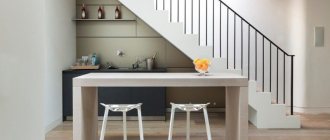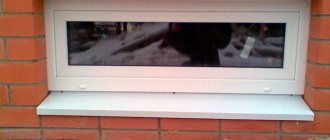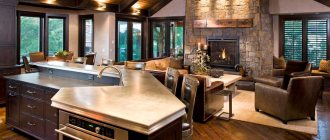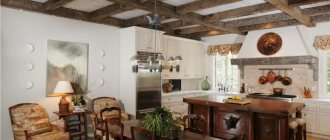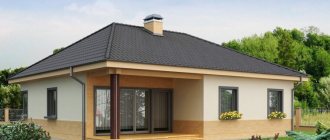Types of balconies in a brick house
Open type
If you are planning a project where the windows are not glazed, then the design of the balcony is not very diverse. There is a standard balcony repair with a regular metal parapet and colored plastic inserts. In the interior of modern apartments, parapets lined with white bricks are often found. The disadvantage of this type of balcony is the weather, so furniture and decorative elements must be light and moveable. They give preference to a design whose size is appropriate and resistant to natural influences.
Before destroying the old appearance of the balcony, it is better to clarify whether it will be possible to design the parapets to your taste.
Closed type
If the functional purpose of the room is determined, then the following work must be performed:
- assessment of the conditions of the balcony - slab and parapet;
- window opening and its glazing;
- insulation and waterproofing;
- possible dismantling of the balcony block;
- electrical wiring;
- leveling walls and floors;
- Finishing work;
- room decoration.
Return to contents
Installation work
First of all, we empty the balcony of all things and disassemble the floor covering to the base. Using a grinder, we cut off the old fence and begin to strengthen the edge of the slab. Regardless of its condition, the edge must be closed with a metal corner 50x50 mm. It will serve as the basis for the lower mounting of the stem frame.
We cut two profiles from the pipe, the same length as the new width of the balcony along the facade. We place one profile on the floor and wall slab and attach it to it.
Along the side edges of the slab we install two profiles for the width of the external balcony, weld them to the wall profile and the corner.
We weld a second element to the ends, similar in size to the wall extension profile.
We prepare two side profiles. Their size is the width of the balcony plus 2/3 of the wall thickness. We make holes along the edges of the wall profile in the wall in such a way as to insert and weld the side elements of the frame. The result is a rectangle - the floor of the future balcony with an extension. We weld the logs in its inner part. The basis of the first part of the balcony extension along the base of the slab is ready.
Next we install gussets - vertical elements of the parapet structure. With their help, we solve the problem of how to make an extension along the windowsill, thereby combining both methods of expansion. To reduce the weight of the structure, we make the elements of the window sill extension from aluminum profiles.
We install horizontal connections, fencing and ceiling elements. The latter, being the rafters of the balcony roof with an extension, serve as fastening elements for the entire spatial frame of the expansion.
The frame is attached to the wall with anchors.
Make brick a decorative element
To prevent the balcony from looking monotonous and uninteresting, preference is given to brick rather than panels or lining. There is a concept of balcony slabs, which are the basis. In old houses, brickwork is not recommended as decoration, since the load on the loggia increases several times, and the permissible load is 210 kg/m2 over the entire area (standard dimensions), while the thickness of the balcony slab varies from 150 to 220 mm. Despite the fact that the balcony can withstand a lot of weight, it is worth considering that over time, the condition of the houses deteriorates and the heavy structure may collapse. Another solution is to strengthen the balcony slab in a brick house or make a brick parapet with your own hands. Laying a brick parapet is a short and not difficult process, but the material must be laid correctly. The structure is fastened to the side walls using metal rods; a metal mesh is placed every 3 layers of brick.
Making a subfloor
After building the foundation, it is recommended to start arranging the subfloor. We first cover the support with roofing felt in two layers.
The floor can be wooden or concrete. For example, in a frame veranda made of wooden beams, a wooden floor would be more appropriate. Concrete pouring will best fit into a brick extension.
Subfloor
We make a wooden subfloor like this:
- We fix the beam of the lower trim on the foundation. We use suitable fasteners, for example, anchors. To connect the beams directly, we first make samples at the places of their joints and additionally fasten them with galvanized nails;
- We attach wooden logs to the bottom trim. We keep the step at 50 cm - this way the floor will definitely not fall through. We use the connection option described above;
- fill the space between the joists with expanded clay;
- We make the flooring from unedged boards or plywood about 50 mm thick. We attach the flooring elements to the joists with galvanized nails or self-tapping screws.
We make a concrete screed like this:
- fill the base with a 10-centimeter layer of sand;
- pour a layer of expanded clay on top;
- lay the reinforcing mesh. For the floor of the veranda, a mesh of rods with a diameter of 6-8 mm with cells of 25x25 cm is sufficient;
- pour concrete.
The recommended thickness of the screed on the veranda is from 30-50 mm. For greater convenience and accuracy of pouring, we can pre-set beacon slats every 2-4 m.
How to make a brick imitation?
If there is uncertainty about how much weight a balcony can support, the best solution is to decorate the balcony with decorative bricks: laying clinker tiles, facing tiles, brick-look wallpaper or PVC panels. Tiles can be smooth or rough, like brick, but they are used only inside a glazed balcony.
Tiles "Bricks"
Install the material in a row, inserting plastic crosses between the tiles. Afterwards, immediately remove the glue that comes to the surface during installation, since frozen glue is difficult to remove, and smeared glue can be easily wiped off with a damp cloth. After a day, when the material sticks well, you need to remove all the plastic crosses and clean the seams in order to fill them with grout later.
Soft tiles
Installation is carried out using PVA construction adhesive, which is applied to the walls. Then the material is attached monolithically. You need to know its structure: the base is plasterboard, the softness regulator is foam rubber and decorative material in the form of leather, suede or textiles. If the tile is damaged, all the decorative brick on the balcony does not need to be demolished, since the damaged part can be removed easily and quickly - you just need to lay a new one in its place.
Monastic tightening between the columns
When the height of the columns reaches the level of the arch, a thick-walled pipe is inserted into them and filled with grade 200 concrete. The pipe should extend 250-300 mm inside the column, its outer part should be 200-250 mm high.
Heels are built along the top of the columns - supports for the future arch. A pre-prepared wooden template for a truncated arch - a circle - is installed on the finished heels. You can read about how to make it in the article about making arches.
For this purpose, ribbed reinforcement with a diameter of 12 mm is selected.
The height of the reinforcement at the top point of the arch should be 130-140 mm, so as not to interfere with the laying of bricks when building the arch.
Thus, the upper parts of the columns are securely fixed with a “monastery tie”, which will prevent them from moving apart under the influence of the weight of the arch.
The basis of the balcony structure, types, dismantling and installation
Recently, there has been a trend towards glazing and insulating balconies. Open balconies, which, according to the architects, were supposed to become a place for relaxing in the fresh air (or for smoking), are becoming less and less suitable for the population. After all, the open area gets dusty, gets dirty from precipitation, becomes a accumulation of all sorts of rubbish marked “a shame to throw away,” but meanwhile it is several meters of area that can become useful. Besides, fifty years ago it was delicious to breathe fresh air and do exercises on the balcony in the morning, but now with so many cars it’s more useful to run to the nearest park.
But before you begin insulation, you need to assess the condition of the balcony slab to see if additional reinforcement is required.
Wood
Classic wooden balconies often become central gathering places in residential buildings; it is important to make them durable and attractive to the eye. Choosing the best type of wood used for construction matters for long-term use and ease of maintenance. A wooden balcony is a very good choice.
The best wood is the one that can withstand the most stress. Pressure-treated wood, with an expected quality guarantee of around 15 years, is used in the vast majority of outdoor balconies, with "green" pine being the predominant variety. Usually the material is treated with an insecticidal preservative. Wooden buildings require additional treatment with repellent every two years. Redwood and cedar woods are naturally rot and insect resistant. When used, expect them to be good for about 20 years.
Slab for balconies and loggias
The balcony slab is the actual basis of the entire balcony structure. The classification by design, as well as the requirements for materials for their production, is explained in the document GOST 25697-83 “Reinforced concrete slabs for balconies and loggias”.
Width and length may vary depending on architectural solutions. As a rule, slabs are manufactured according to the following parameters; this also applies to loggia slabs:
- Length - from 1.2 m to 7.2 m
- Width - from 1.2 m to 1.8 m
- Thickness - from 15 cm to 22 cm
Developing a plan
During the construction process, you must strictly follow the work plan, technical documentation, and nothing else, because any arbitrariness threatens you with serious consequences, at a minimum - the indignation of your neighbors, at a maximum - you may lose your new building, and you will be held administratively liable. What should be included in the plan:
- collect all the necessary documents for official registration,
- consider options for existing balcony designs,
- draw up a room plan,
- calculate the estimate.
Let's start with the most time-consuming procedure. Only after assessing the scope of work on official registration, you can understand whether you have a chance to obtain permission for an extension.
Features of fastening balcony slabs
Depending on the choice of fastening the balcony slabs, the following types of structures are distinguished:
Console
The most striking example of such a model is Khrushchev. The reinforced concrete sheet is pinched in the wall of the building between the load-bearing walls. For the cantilever type of fastening, balcony slabs with a thickness of up to 12 cm are selected. Large thicknesses will create unnecessary load from the sheet’s own weight.
Beam
Support is provided by reinforced concrete, metal or wooden beams. The supports themselves are laid in a load-bearing wall 40 cm deep.
Invoices
The lightest balcony structures. They are connected to the facade of the building with anchor fasteners. This structural element is not designed for high load capacity, so when designing it you need to choose lightweight materials. It is also necessary to periodically inspect the fasteners for visible damage.
Hanging
Fastening occurs through overhead brackets, which can be located under or above the canvas.
The support is provided by columns or walls that go directly from the foundation. This version of the balcony is popular in private homes.
How much weight can a balcony support?
To find out what maximum load a balcony in a panel or brick house can withstand, you can look at the document SNiP 2.01.07-85. You also need to take into account the age and condition of the balcony.
For a panel and brick house in good operating condition, the maximum load is 200 kg/m².
Now it is enough to measure the dimensions of the balcony slab. Knowing the width and length, we multiply these values and get the area. We multiply the area by the maximum load of 200 kg/m² and get the permissible load for the entire balcony, that is, how many kg. If the length of the balcony leaf is 3 m, the width is 1.2 m, then the load will be 720 kg.
But this is not a pure value, since the age of the building, the weight of windows, cladding, flooring, people (who may be on the site at the same time) and the weight of possible precipitation must be taken into account (for example, snow or ice can weigh up to 200 kg). If you subtract all these parameters from the resulting 720 kg, then the output will be about 130 kg.
This means that on a balcony measuring 1.2x3 m you can place things with a total weight of no more than 130 kg. Moreover, the older the building, the higher the wear and tear of the structure, and the fewer items can be placed.
Bottom line
Installing a balcony in private buildings is a good solution. Residents will feel the lack of this space very quickly, especially if they previously lived in a house or apartment with a balcony. But such construction procedures require experience and certain knowledge, therefore, both at the planning stage and at the construction stage it is worth using the help of specialists. First of all, out of security interests. As for functionality and design, a large number of designs and designs for such extensions will allow you to choose the most suitable solution.
In what cases is repair of a balcony slab required?
If there are cracks on the surface of the balcony, then this is a serious reason to turn to professionals. There is no point in delaying this matter, as the destruction of the balcony that has begun will progress. Only a specialist can determine the degree of destruction. Even seemingly small cracks can turn out to be quite deep.
Signs of an emergency condition of a balcony:
- part of the concrete structure fell off
- reinforcement exposed
- cracks have appeared (cracks are especially dangerous where the canvas is fixed to the wall)
- the concrete covering above or below the canvas has been damaged (you can’t just pour concrete, as this will not strengthen the concrete structure in any way, but will only add extra weight)
Waterproofing walls
The process of waterproofing the surface of the walls of a completed balcony can be done using the following methods:
- Painting. The most common, but expensive option. Protective agents are applied to the surface: varnishes with rubber additives, which must be renewed regularly.
- Pasting. Such materials can stick due to exposure to high temperatures or self-adhesive. The more common material is roofing felt. But the process of working with this material is labor-intensive.
- Powder. It includes a regular cement mixture to which liquid rubber, some types of plaster or tile adhesive are added. The disadvantage of this method is its low strength and resistance to mechanical damage.
- Water repellents. They are ready-made mixtures that have excellent water-repellent properties and provide protection from high humidity. The disadvantage is the rapid destruction from direct sunlight.
This method should only be used for hydraulic internal insulation.
Who is responsible for repairing balconies?
To answer this question, you need to refer to Resolution No. 491 of August 13, 2006 “On approval of the Rules for the maintenance of common property in an apartment building,” which clearly states that balcony slabs are part of the common property:
This means that the repairs fall on the shoulders of the HOA, housing cooperative or other management company (depending on the method of management in your house). The same document states that the owner of the apartment can carry out repairs to the balcony on his own.
If you are lucky with a management organization, they will quickly respond to your request and repair the rotten slab. A balcony in this state poses a danger to both residents and passers-by. Therefore, if financial capabilities allow, it is better to contact a specialized company and carry out repairs at your own expense quickly and reliably. Then, having provided an estimate of the cost of the work, you can recalculate the rent.
Required documents
- Certificate of ownership of the living space on the territory of which construction will take place.
- Plan of the first floor of the house, certificate from the BTI.
- Permission from housing and communal services.
- Consent in writing from neighbors above, left and right with their signatures.
- The prepared project itself.
- Permits obtained from public utilities.
- Photos of the place where construction is expected to begin.
- Permission from the architectural department.
It is also necessary to provide documents confirming the transfer of land to the construction company, and a technical passport of the land. If you can’t get ownership of it, you can rent it or make a balcony on stilts.
Attention! Typically, collecting all documents takes from four months to a year, and the application is reviewed by the administration up to 45 days.
Strengthening the balcony slab in Khrushchev
Depending on the type of building and the scale of the problem, there are several ways to strengthen a balcony slab:
- If the reinforcement of a partially destroyed balcony slab from below is damaged no more than 10%, then it can be treated with a special compound - concrete contact.
- For concrete walls, a suitable option is to strengthen the balcony slab, when an additional slab is attached end-to-end to the bottom one. Elements of steel reinforcement must be connected to each other by welding.
- The balcony can be strengthened with diagonal elements - jibs. This type of work can only be performed by a specialist.
- Strengthening the balcony and its slab can be done by replacing the parapet and railings with more durable structures.
Strengthening the balcony slab is carried out using the following technology
The service life of a balcony slab in Khrushchev during construction was set at 15-25 years, and now almost all balconies require reinforcement. Procedure:
- Dismantling all old balcony elements
- The floor is cleared of debris.
- The next stage is dismantling the cement screed.
You can use a hammer drill, but you need to dismantle it carefully so as not to transmit vibration to the stove. Thus, about 200 kg of weight is released. If there are gaps on the balcony at the junction between the canvas and the wall, then after cleaning they can be sealed with roofing felt, having previously been coated with liquid bitumen. Additionally, this place needs to be reinforced with a metal corner mounted on an anchor. If the railing is rusted at the base, then it definitely needs to be replaced. The end part of the canvas is leveled, then the 63rd corner is laid on a special compound along the entire perimeter and scalded. Special braces are installed on both sides, which partially redistribute the load from the balcony slab to the load-bearing wall.
A metal structure made of a profile pipe under a metal-plastic frame and roof is attached to a solid base.
This algorithm of action is suitable for strengthening all types of balcony structures, with the exception of the French-type balcony (those small balconies with a small projection, or without, and a forged fence). The structure of such a building element differs from the usual balcony. The purpose of these extensions is completely different, namely:
- the possibility of using panoramic windows with a full opening function for ventilation,
- organizing space for flowers,
- admiring the beautiful view.
Repairing a balcony requires knowledge of all the nuances of the technical structure of the structure, correct calculation of the permissible load and compliance with safety precautions (since the work is carried out at height). Therefore, it is better to delegate these works to specialized companies that will invite experienced specialists and, if necessary, bring in special equipment.
The neighbor is almost invisible
There have always been enough people wanting to improve, and in the understanding of the majority, this means expanding their balcony. The current ones are no exception. Therefore, many multi-storey buildings amaze with the variety of frames, awnings, and other bells and whistles on the balconies, which greatly disfigure the appearance of the houses.
The Supreme Court of the Russian Federation made this clarification when reviewing the results of one “balcony” dispute. The point was that one of the owners of an apartment in an apartment building had remodeled her balcony.
Her reconstruction was, in fact, standard - this is what those who want to improve their balcony often do; the lady combined it with the kitchen, and at the same time increased its size. In addition to this, the owner installed a canopy over the balcony of such a length that it blocked the view of the neighbors above.
Neighbors, outraged by this inconvenience, contacted local authorities. Those who did not like the alteration either, and the authorities demanded that the apartment be returned to its previous state, claiming that the defendant started the redevelopment without permission from the competent authorities and without the consent of the neighbors. For their part, the residents of the house filed their own lawsuit. According to the neighbors, the balcony canopy extends approximately 1.5 meters beyond the balcony slab, which spoils both the view from the balcony and the image of the house.
The lady did not give up and responded with a counterclaim. In it, she wrote that she had collected a bunch of permits from all authorities and asked not to interfere with her enjoying life with a new and safe balcony.
talk about legal issues of managing an apartment building in the “Legal Consultation” section.
Judging by the documents obtained by the court, the reconstruction of the balcony meets both sanitary and fire safety requirements. And according to experts, there were no violations of the load-bearing structures during the redevelopment. During the trial, it turned out that the upcoming renovation of the balcony was approved by 49 neighbors and the owner of the non-residential premises of the house.
Local courts sided with the apartment owner.
In their opinion, the reconstruction of the balcony was carried out taking into account the requirements of construction and sanitary standards and regulations, does not in any way violate the rights and interests of the owners of other apartments, does not create a threat to their life and health and does not change the “purpose of the premises.”
But the city authorities and other neighbors did not agree with this decision and challenged it to the highest authority. The city authorities considered that such a decision was dangerous primarily because now everyone will be able to rebuild the balconies according to their taste and desires. It’s hard to imagine what the face of the city will turn into.
The Judicial Collegium for Civil Cases of the Supreme Court of the Russian Federation carefully studied the “balcony” dispute and did not agree with the opinion of its colleagues. The Supreme Court said that the citizen carried out the redevelopment without permission, she did not receive permits, and did not obtain approvals from the authorities and neighbors. The highest authority explained that the balcony slabs are part of the common property, and, therefore, any redevelopment of them must be agreed upon with all owners of the premises in the house.
If you open the main document in such cases - the Housing Code of the Russian Federation, then paragraph 3 of part 1 of Article 36 says the following: all owners of premises in an apartment building own common property: roofs, enclosing load-bearing and non-load-bearing structures of a given house, mechanical, electrical equipment and other equipment .
The Supreme Court specifically emphasized that balcony slabs belong to common property. This is stated in the document called “Rules for the maintenance of common property in an apartment building.” These Rules were approved by government decree No. 491 of August 13, 2006.
These Rules contain paragraph 2 of Section I “Determination of the composition of common property”. The following is written there verbatim: “The common property includes, inter alia, the enclosing load-bearing structures of an apartment building (including foundations, load-bearing walls, floor slabs, balcony and other slabs, load-bearing columns and other enclosing load-bearing structures),” it says. .
Thus, the Judicial Collegium for Civil Cases of the Supreme Court emphasized, a balcony also refers to enclosing and load-bearing structures, the definition says.
The court in its decision stated that the tenant can reduce the size of the common property during the reconstruction of the premises, but such redevelopment is possible only with the consent of all owners of the premises in the house (Part 3 of Article 36 of the Housing Code of the Russian Federation). The same provision is enshrined in Part 2 of Article 40 of the same code - “if reconstruction, reorganization or redevelopment of premises is impossible without adding part of the common property to them, the consent of all owners of premises in an apartment building must be obtained.”
This is the conclusion that the Supreme Court summed up in its reasoning - in case of serious redevelopment of a balcony in one individual apartment, the consent of all owners is a prerequisite.
And the local courts considered the consent of four dozen neighbors quite sufficient. But local courts did not take into account that there were more opponents to the reconstruction of the balcony. Meanwhile, neighbors who categorically object to the expansion of the balcony filed a collective appeal to the court, and it is available in the case materials.
“The Judicial Collegium for Civil Cases of the Armed Forces of the Russian Federation finds that the violations of substantive law committed by the courts of the first and appellate instances are significant, they influenced the outcome of the case and without their elimination it is impossible to restore and protect the violated rights,” the decision of the Supreme Court of the Russian Federation says.
The court overturned all decisions made in the case and sent it for a new trial, ordering that the position of the RF Armed Forces be taken into account.
Some important nuances
The majority of urban homeowners, regardless of any prohibitions, add small balconies, taking advantage of the ignorance of the city authorities. It’s good if you come across neighbors who are on the lookout. They will definitely report where they should, and a huge number of problems will fall on your head in an instant. But if you live quietly and peacefully, and you have friendly relations with your neighbors, then there is a high probability that you will live in an apartment with an attached balcony for the rest of your days, and no one will ever make any claims against you.
But you need to take into account this point - you will not be able to sell, exchange or give such an apartment. Forget about it, because you will first have to legalize this premises, that is, present it to the authorities. They may allow it to be left unchanged, or they may require its demolition and restoration of the apartment to its original condition. Of course, a fine will definitely be imposed on you, and all this will go through the court. The problems will be through the roof, so we recommend not to engage in self-construction, but to follow the letter of the law. However, this path is thorny, and it will not be so easy to go through it.
We recommend: Gas leak sensors - types and principle of operation, how to choose, the best models
What are the options?
- Contact intermediaries with connections in government. Usually these are lawyers or law firms. Their service may cost you half the legal cost. But without problems, fuss and nerves, and the speed of obtaining the necessary permits will be 3-4 times higher.
- Solve this issue yourself. Remember that you will have to go around more than one government agency, stand in line, get signatures and seals. You may be driven from one door to another several times. So be patient.
Installation of balconies, loggias, bay windows in buildings with various structural systems.
Balconies:
This is an open area that is fenced to a partial height.
Installation of balconies.
1) For longitudinal load-bearing walls:
– Balcony cantilever slab
-Cantilever release of the floor slab
2) For transverse load-bearing walls. Frame walls:
Can they refuse?
When coordinating the project, special circumstances may arise due to which it will not be possible to build a balcony on the ground floor.
Basic rules prohibit its extension if:
- Your home is an architectural monument.
- The side of the house where construction is supposed to begin faces one of the central streets of the city.
- An extension will spoil the appearance of the house or may damage the structure.
- The materials from which the balcony will be made or the technique for its construction are outdated and do not comply with accepted modern standards.
- During the construction process, it is planned to damage one of the load-bearing walls.
- The location of underground communications interferes with construction (they are closer than 2.5 meters).
DESIGNS OF BALCONIES, BAY WORDS, LOGGIAS
Author: admin · Published 12/07/2017 · Updated 07/28/2018
A balcony is an architectural and structural element that forms a platform protruding at a certain height beyond the wall.
Balconies in old residential buildings are, as a rule, two reinforced concrete or metal consoles, brackets embedded in the masonry to a depth of at least 38 cm. The overhang of balconies is usually within the range of 1 - 1.6 m.
Balconies with a small overhang are made in the form of a load-bearing cantilever reinforced concrete slab. The slab is made of natural stone, monolithic or precast reinforced concrete (Fig. 1, a). The cantilever seal is the most critical part of the structure.
Sometimes, if the weight of the overlying masonry is insufficient, the slab is additionally secured with anchors to the underlying wall masonry. The end of the slab facing the inside of the room is additionally insulated to prevent it from freezing. To prevent the slab from getting wet, it is protected with a waterproofing carpet.
Balconies on cantilever beams have a number of design solutions. The consoles were made of steel or reinforced concrete (Fig. 1, b) beams. Slabs of natural stone or reinforced concrete were laid on the cantilever beams. Often, with steel cantilever beams, the filling between them was done in the form of brick or concrete vaults.
Metal beams were embedded in the wall to a depth of 38–44 cm. If the metal beams were not concreted, then they were painted with oil paint to protect them from corrosion. Often the beams were plastered over a grid or covered with architectural details.
To prevent the masonry under the cantilever beam from experiencing high stress from crushing, metal pads were laid below and above.
Reinforced concrete cantilever beams were also embedded in the walls to a depth of at least 38 cm. If the building frame was reinforced concrete, then the beam was monolithically connected to the framing beam of the frame.
The number of beams depends on the length of the balcony. Usually they were placed at a distance of 1–2 m from each other. Some of the beams could be decorative as an element of architectural design.
The destruction of balconies of industrial buildings occurs mainly for two reasons:
- design features - due to the absence of a drip line on the bottom surface of the slab along the contour, and drains made of galvanized roofing steel along the top of the slab, the presence of a reverse slope of the balcony slab, the installation of enclosing screens to the balcony floor, which causes the accumulation of snow, as well as due to untimely removal his;
- operational shortcomings - due to untimely restoration of destroyed drains and the protective layer of the reinforced concrete slab, installation of fencing screens without taking into account the operating features of the balcony slab. Balcony fencing is usually made in the form of a metal lattice. The most critical areas are the places where fence posts are embedded in the slab and handrails in the wall.
Rice.
1. Balcony structures: made of reinforced concrete slabs; b – on reinforced concrete consoles; 1 – balcony slab; floor slab; 3 – insulation; 4 – cement screed; 5–waterproofing carpet; b–floor; 7–drain. 8 – beam. Steel parts of balconies must be protected from moisture. To protect the beams from corrosion, they are concreted. Cement-sand or gypsum parts were used as architectural decorations for balconies. Fastening parts are the most susceptible to destruction, so special attention is paid to their protection from atmospheric influences.
Brick vaults, which are the load-bearing filling between metal beams, were usually laid out on lime mortar, which, when moistened, quickly collapses over time.
Rice. 2. Bay window design: a – section along the bay window; b – plan of bay window beams; 1 – lightweight outer wall; 2 – overlap; 3– cement floor; 4 – slag; 5 – parquet; 6 – subfloor; 7–backfill; 8–reinforced concrete slab; 9 – plaster.
A bay window is a part of a room enclosed by external walls, located behind the outer plane of the facade wall (closed balcony). The bay window increases the usable area of the room and somewhat improves insolation. In addition, it serves as a compositional means for the vertical division of the facade.
The bay window consists of a supporting and enclosing structure. The elements of the supporting structure are two or more single-span beams with consoles embedded in the outer or inner walls (Fig. 2).
The elements of the enclosing structure of the bay window (walls, ceilings, floor) must have the necessary thermal resistance and low density, so the material for them is usually hollow ceramics, multi-hole or slotted brick, foam concrete or reinforced concrete panels with an internal insulating layer.
The bay window cover often serves as a balcony for the floor above – a flat roof.
Loggia is a room open on one or more sides, included in the overall volume of the building and fenced from the outside with a parapet. A loggia can be a separate structure or a type of balcony recessed into the building.
Loggias are based in old buildings mostly on slabs or floor beams, in modern construction - on protruding pilasters. Water drains from the loggias through drainage holes. The slope of the loggia floor must be at least 5%. Loggia floors are usually waterproofed with rolled roofing carpet or other insulating material.
Similar articles
about the author
Material
Durable and durable materials are used to make balconies. Most often it is concrete and wood.
Concrete balcony
This architectural structure has its own characteristics:
- load-bearing structures are recessed into the wall. The reliability of the structure depends on the thickness of the wall; if it is not very strong, then additional supports are used;
- the balcony overhang is at least 1 meter in length;
- if the house is brick, then the base slab is inserted into the wall along its entire length;
- the upper level of the slab is set 5-8 cm below the expected level of the floor covering;
- the concrete base must be thoroughly waterproofed;
- The height of balcony railings should not be less than 1 m.
Wooden balcony
Usually inferior to concrete in size and reliability, but superior in decorative terms. Externally, the balcony resembles a cozy wooden house or hut. Wood is a material that has many advantages. First of all, it is the atmosphere of comfort that natural wood creates, its smell and appearance. Wood goes well with different finishing materials.
Features of a wooden balcony:
- for the manufacture of load-bearing structures, beams with a cross section of 10*20 cm are used;
- the minimum depth of beams in a stone facade should not be less than 25 cm;
- the beams are fastened to the walls with bolts or metal angles;
- vertical posts (boards 4*10 cm) and longitudinal ones (5*10 cm) are attached to the console;
- flooring and handrails are installed;
- All elements made of wood and metal are treated with oil paint, gratings and handrails are coated with frost-resistant and water-resistant varnish.
The gaps between the lattice bars for any structure should not be wider than 10-12 cm.
